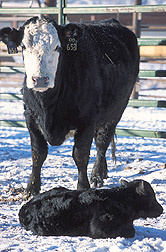Read the magazine
story to find out more. |

ARS scientists have developed
the first way to test tissue samples that have been preserved in formalin for
the presence of abnormal prions that cause transmissible spongiform
encephalopathies like Mad Cow Disease. Click the image for more information
about it.
|

|
New Techniques Developed for TSE Testing
By Ann Perry
May 6, 2009
Agricultural Research Service (ARS) chemist Eric Nicholson and veterinarian Robert Kunkle have found a way to facilitate the diagnosis of transmissible spongiform encephalopathies (TSEs), a deadly group of diseases that can develop in a range of mammals, including humans.
A TSE can only be definitely diagnosed after an animal has died. During the diagnosis, researchers typically check tissues for abnormal proteins called prions using a technique called Western blotting, or with immunohistochemistry. Western blotting is used for fresh or frozen tissues. Tissue that has never been frozen and has been fixed in formalin--a solution used to preserve biological specimens--is tested with immunohistochemistry. Sometimes only formalin-fixed tissues are available for testing.
Nicholson and Kunkle, who both work at the ARS National Animal Disease Center in Ames, Iowa, found a way to extract and identify abnormal prions in formalin-fixed tissue using a combination of mild detergent, a series of freeze-boil cycles, and enzyme digestion. Initial results indicate that the accuracy of this method begins to decline two years after the tissue is first preserved, and is completely lost at the end of six years.
Nicholson and Kunkle also wanted to see if they could find a way to use Western blotting to test for TSE in tissues that had been fixed in formalin and then preserved in paraffin. They found that their results equaled--and at times even exceeded--the effectiveness of Western blotting analysis for tissues that had only been fixed in formalin.
These combined results add to the tools animal scientists can use to study the development and spread of TSE diseases. Their findings will facilitate the testing of tissue samples by Western blotting that were originally archived for microscopy examination, and simplify the preservation of samples collected in the field.
Read more about this research in the May/June 2009 issue of Agricultural Research magazine.
ARS is the principal intramural scientific research agency of the U.S. Department of Agriculture.